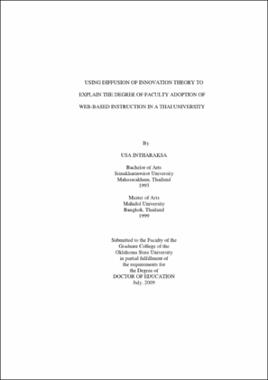| dc.contributor.advisor | Harris, Edward L. | |
| dc.contributor.author | Intharaksa, Usa | |
| dc.date.accessioned | 2013-11-26T08:33:21Z | |
| dc.date.available | 2013-11-26T08:33:21Z | |
| dc.date.issued | 2009-07 | |
| dc.identifier.uri | https://hdl.handle.net/11244/7225 | |
| dc.description.abstract | Scope and Method of Study: | |
| dc.description.abstract | Using the framework of Rogers's (1995) Diffusion of Innovation Theory, the purpose of the study is to examine the use of web-based instruction and faculty perceptions of web-based instruction in a Thai university. In this study, interviews with seven participants were used as the primary method to collect data. Meanwhile, other sources of data including documents, web pages on Course Management System (CMS) observations, and face-to-face classroom observations were used. | |
| dc.description.abstract | Findings and Conclusions: | |
| dc.description.abstract | The findings of this study revealed that at TSU, a blended learning approach was used in web-based instruction. Seven participants held an optimistic view towards the practice of web-based learning as a supplementary tool to enhance a traditional mode of teaching and learning. Web-based instruction benefited faculty members, students, and the university. | |
| dc.description.abstract | The results of the study showed that four attributes of innovation--relative advantage, compatibility, trialability, and observability--accelerated the rate of web-based instruction use. Another attribute, complexity, is negatively related to the rate of adoption in that if technology is difficult to understand and use, it will be refused. However, from the findings, the Course Management System (CMS), which was used for web-based instruction, was not complex to use. Thus, faculty members did adopt CMS as a part of teaching and learning. These five basic characteristics of innovation were interwoven throughout the teaching and learning process. | |
| dc.description.abstract | The participants were concerned about the workload and time demand for non-adopters, infrastructure, and students' access and familiarity with computers and web-based instruction. Moreover, they suggested that ongoing workshop training, support staff, and a Technology Unit were also needed. | |
| dc.format | application/pdf | |
| dc.language | en_US | |
| dc.rights | Copyright is held by the author who has granted the Oklahoma State University Library the non-exclusive right to share this material in its institutional repository. Contact Digital Library Services at lib-dls@okstate.edu or 405-744-9161 for the permission policy on the use, reproduction or distribution of this material. | |
| dc.title | Using diffusion of innovation theory to explain the degree of faculty adoption of web-based instruction in a Thai university | |
| dc.contributor.committeeMember | Dugger, Cecil W. | |
| dc.contributor.committeeMember | Wanger, Stephen P. | |
| dc.contributor.committeeMember | Kelsey, Kathleen D. | |
| osu.filename | Intharaksa_okstate_0664D_10424.pdf | |
| osu.accesstype | Open Access | |
| dc.type.genre | Dissertation | |
| dc.type.material | Text | |
| dc.subject.keywords | diffusion of innovation | |
| dc.subject.keywords | faculty perceptions | |
| dc.subject.keywords | thai university | |
| dc.subject.keywords | web-based instruction | |
| thesis.degree.discipline | Applied Educational Studies | |
| thesis.degree.grantor | Oklahoma State University | |
